Frosty
Purpose: To determine how frost forms.
Procedure: Sophia and Olivia placed glass jam jars in the freezer for 30 minutes. They removed the jars and allowed them to sit on the table undisturbed for 30 seconds.
The girls waiting as the glass frosted.
(Apparently the 30 second waiting period was not too exciting.
They both look like they're sleeping and/or bored.)
According to Earth Science, "Frost is not frozen dew. Frost forms when water vapor changes directly to a solid. The glass is cold enough to cause the water vapor in the air to cool so quickly that it sublimes (changes from a gas to a solid without forming a liquid)."
Olivia scratching a design in the jar.
They scratched the cloudy/frosty formation on the outside of the jars with their fingernails to create patterns.
Sophia scratched a design
in the frost on her jar.
Floating Flakes
Purpose: To demonstrate why snowflakes float.
Procedure: The girls took one piece of paper and divided it in half. They crumpled one of the sheets into a ball and left the other flat.
Cutting and folding the paper to simulate
a raindrop and snowflake.
They held the flat sheet in one hand and the crumpled sheet in the other hand. They dropped both sheets at the same time.
Sophia holding the two pieces of paper
at the same distance from the floor
before letting them drop.
The crumpled sheet hit the floor first each time they did the experiment. The flat sheet floated slowly downward.
The crumpled pieces of paper are on the floor, and
the flat pieces of paper are floating down.
Why did this happen? According to Earth Science, "The downward pull of gravity is the same on both sheets of paper, but the upward force of air on each sheet is not the same.
"Raindrops and snowflakes are both made of water, but they have different shapes. The raindrop, like the crumpled paper, takes up a small amount of space and falls more quickly than does the flat sheet of paper, which behaves like a snowflake.
"The flat paper, like snowflakes, falls slowly because it has a greater exposed area and thus receives more upward force from the air."

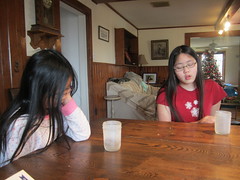
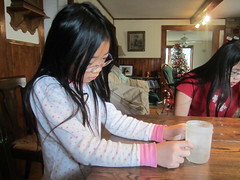
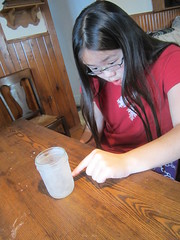
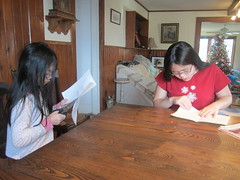

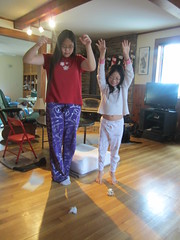
No comments:
Post a Comment